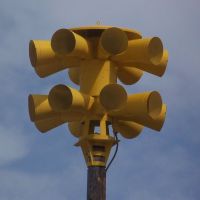15V2T
| Sentry 15V2T | |

| |
| Company | Sentry Siren, Inc. |
|---|---|
| Produced | 1986-Present |
| Type | Omnidirectional Electromechanical |
| Sound output | 124 dB @ 100 ft |
| Frequency | 60 Hz |
| Horsepower | 15/16 hp |
| Voltage | 208-230/460 V AC
1 or 3 ph
72 V DC |
| Preceded by | Sterling Model M |
| Documentation | Product sheet |
The 15V2T is a siren that is produced by Sentry Siren, Inc. Introduced as a stopgap between the 10V2T and 20V2T, it is a solid and popular choice for cities looking for a midrange dual rotor siren. The 15V2T continues to sell well to this day and is Sentry's most popular dual tone siren. With the 20V1T and 16V1T-B being sold as single tone by default, the 15V2T and 40V2T are the last sirens on the US market that are sold as dual tone by default. It can be expected that the 15V2T will remain a popular choice for years to come.
History and design
The 15V2T was introduced in 1986 and has the distinction of being the first siren introduced by Sentry after their lineup in 1980. It was likely designed as a middle option between the 10V2T and the 20V2T, as the 20V2T costed significantly more. The 15V2T is nearly as loud as the 20V2T, while also not being quite as expensive, which makes it more appealing to customers. Like the two other sirens, the Sentry 15V2T makes use of the Sterling Model M's rotor and stator.
15V2T
The 15V2T shares the same design as the 16V1T-B and 20V2T, being a large dual rotor siren with 8 long horns attached to each stator port. On the 16-port side, two port holes are shared per horn. Unlike the 10V2T, the 15V2T has equal length horns. The 15V2T comes stock with these horns, however the siren can be ordered with skirts instead of horns if the customer wants it. On older units, these horns are flat at the end, but later production 15V2T units use pointed horns to help keep debris out. The 15V2T comes standard in either single or three phase power. Three phase units are powered by dual sided 15 hp AC motor, while single phase units are powered by two single sided 7.5 hp AC motors. Single phase units use a centrifugal regenerative brake which slows the rotor down rapidly when the rotor reaches a low enough RPM in order to recharge the motor's capacitor. The 15V2T comes standard in 8/16 port dual tone as standard, though 8/8 or 16/16 port single tone are available through special order as the 15V1T. The siren is able to reach 124 dB at 100 ft as claimed by Sentry.
Due to being a vertical omnidirectional siren, its design is quite simple and similar to Sentry's other sirens. The siren itself is held up by a 6-legged mount which is directly attached to the bottom stator, which has a cone on the bottom to project the sound from the intakes better. The motor (or motors, if it is a single-phase model) is in the middle of the siren, between the two rotors. It is protected by a cylindrical motor cover with ventilation holes to protect the motor from the elements. Notably, due to single phase units using two motors, the motor cover is significantly taller than three phase units, which makes them easy to differentiate visually. The upper intake on the siren is protected by a large rainshield, that keeps debris and moisture out of the top rotor. An eyebolt is also included to make installation easier. The 15V2T comes with 16 horns, all of which are equal in length. The 8-port rotor is always located on the bottom, while the 16-port rotor is always on top. The 16-port side has two ports per horn. The horns and both intakes are protected by mesh screens to help keep debris out of the rotors.
15V2T-B
In 2002, Sentry began to experiment with DC battery backup capable sirens, which led to the creation of the Defender, 7V8-B, and 15V2T-B. The 15V2T-B is largely identical to the standard 8/16 port 15V2T, however it uses a pair of single sided 8 hp 72 V DC motors instead of AC motors. The siren was also available in either 8/8 or 16/16 port single tone as the 15V1T-B. It originally used a single dual sided 15 hp DC motor, but this was changed early on due to the strain it put on the batteries. Due to the asynchronous nature of DC motors, the two motors often do not run at the same speed, causing the siren to make a distinctive warbling sound as the two rotor sounds clash. While this is more attention grabbing, this has the effect of harming the siren's range due to the cancellation created by the sounds clashing. In appearance, it looks the exact same as a single phase 15V2T, and the only way to visually differentiate the two is the branding, and the battery box next to the controller. The 15V2T-B was ultimately deemed a success, and became the single tone 16V1T-B in the year 2004. A few units are still in service today.